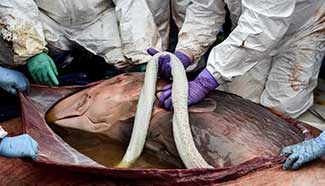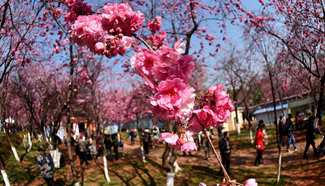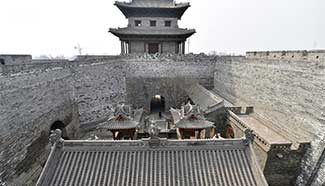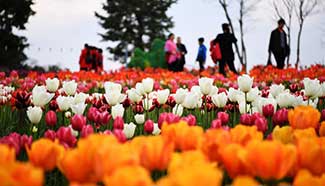SAN FRANCISCO, March 16 (Xinhua) -- The increased efficiency of grass stomata, as confirmed in a new study, may lead to crops that can better survive climate change.
Stomata, the holes in the leaves of land-based plants through which they take in carbon dioxide (CO2) and let out oxygen and water vapor, have remained largely unchanged in the 400 million years since plants colonized the land, according to a resarch paper published in the March 17 issue of the journal Science.
One major exception is grasses, which are better able to withstand drought or high temperatures in large part due to changes in their stomata.
Stomata usually have two so-called "guard cells" with a hole in the middle that opens and closes depending on how a plant needs to balance its gas exchange. If a plant needs more CO2 or wants to cool by releasing water vapor, the stomata open. If it needs to conserve water, they stay closed.
Grasses, which include wheat, corn and rice and make up about 60 percent of the calories people consume worldwide, improved on the original structure by recruiting two extra cells on either side of the guard cells, allowing for a little extra give when the stoma opens. They also respond more rapidly and sensitively to changes in light, temperature or humidity that happen during the day.
The different stomata may have helped grasses spread during a prehistoric period of increased global dryness.
Scientists have assumed grasses' unusual stomata make these plants more efficient "breathers." But, spurred by curiosity and a passion for developmental biology, researchers at Stanford University decided to test that theory.
The researchers of the study said they found a mutant of the wheat relative Brachypodium distachyon that had two-celled stomata, compared the stomata from the mutant to the normal four-celled stomata, and confirmed that the four-celled version opens wider and faster.
In addition, they identified which gene creates the four-celled stomata.
"Because it was a grass-specific cell-type, we thought it would be a grass-specific factor as well," said Michael Raissig, lead author of the paper and a postdoctoral researcher in the lab of Dominique Bergmann, professor of biology. "But it's not."
The recruitment of the extra cells seems to be controlled by a well-studied factor which is known to switch other genes on and off. In other plants, that factor is present in guard cells, where it is involved in their development. In grasses, the researchers found that the factor migrated out of guard cells and directly into two surrounding cells, recruiting them to form the four-celled stomata.
Over evolutionary time, humans have bred and propagated plants that produce the kinds of foods we like and that can survive extreme weather.
"When we want something that's more drought resistant, or something that can work better in higher temperatures, or something that is just able to take in carbon better, often what we are actually doing is selecting for various properties of stomata," Bergmann, co-author of the paper, was quoted as saying in a news release.
The adaptability and productivity of grass makes understanding this plant family critical for human survival, the researchers said. Whether through genetic modification or selective breeding, these findings may lead to producing other plants with four-celled stomata.












